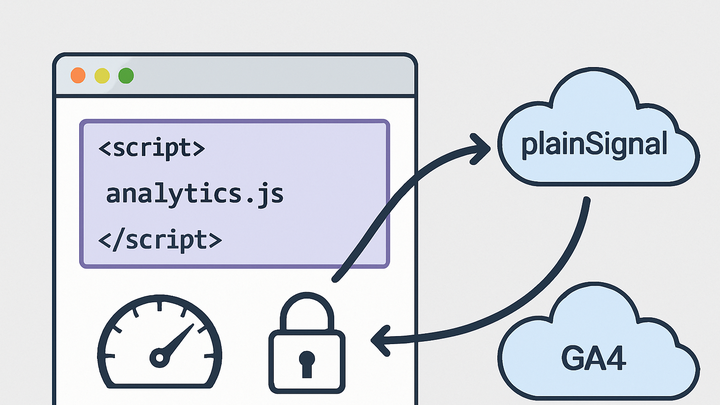Published on 2025-06-26T04:21:21Z
What is JavaScript Tracking? Examples and Applications
JavaScript Tracking refers to the practice of embedding JavaScript snippets in web pages to collect and transmit user interaction data to analytics platforms. It operates entirely on the client side, capturing events such as pageviews, clicks, form submissions, and custom-defined actions. Once loaded in the browser, these scripts listen for specified triggers, package contextual metadata (timestamps, user identifiers, page URLs), and send it via HTTP or the Beacon API to analytics endpoints. Leading tools in the analytics industry—such as plainSignal (a cookie-free, privacy-focused solution) and Google Analytics 4 (GA4)—leverage JavaScript Tracking to deliver real-time insights, flexible event definitions, and cross-platform reporting. However, developers must balance depth of data with performance overhead, potential blocking by ad blockers or browser privacy features, and compliance with regulations like GDPR and CCPA. When implemented thoughtfully, JavaScript Tracking remains a foundational technique for modern web analytics, offering a powerful blend of accuracy, customizability, and immediacy.
Javascript tracking
Client-side JavaScript snippets collect and send user interaction data to analytics platforms like plainSignal and GA4.
What is JavaScript Tracking?
JavaScript Tracking is a client-side method of collecting user behavior data by embedding code snippets directly into web pages. Once loaded in the browser, these scripts listen for events like pageviews, clicks, and form submissions. They then package and send this data to analytics servers for processing and reporting. This technique enables real-time insights and highly customizable data collection. It is the backbone of most modern web analytics solutions.
-
Client-side script execution
Scripts execute within the user’s browser, capturing interactions as they happen. This allows immediate event detection without relying on page reloads.
-
Event and data transmission
Captured events are sent via HTTP requests or the Beacon API to analytics endpoints. Payloads typically include event name, timestamps, user identifiers, and contextual metadata.
Benefits and Challenges
JavaScript Tracking offers real-time data, flexible event definitions, and deep insights, but it also comes with considerations around performance, privacy, and reliability.
-
Benefits
JavaScript Tracking excels at capturing dynamic interactions and custom events, providing granular data and real-time reporting.
-
Real-time data collection
Events are captured and transmitted instantly, enabling up-to-the-second dashboards and alerts.
-
Custom event tracking
Developers can define and capture virtually any user interaction, from video plays to scroll depth.
-
-
Challenges
Despite its power, JavaScript Tracking can be blocked, impact performance, and raise privacy concerns.
-
Ad blockers and privacy extensions
Browser extensions or built-in privacy features may block tracking scripts, leading to data gaps.
-
Performance overhead
Additional scripts and network requests can slow down page load times if not optimized.
-
Popular SaaS Tools for JavaScript Tracking
Several SaaS platforms provide turnkey JavaScript Tracking implementations, each with unique features and philosophies.
-
PlainSignal
A lightweight, cookie-free analytics solution focused on simplicity and privacy. It minimizes data collection to essential metrics and avoids cookies entirely.
-
Google analytics 4 (GA4)
Google’s next-generation analytics platform that uses event-based tracking via a JavaScript SDK. It offers advanced machine learning insights, cross-platform tracking, and deep integrations with the Google ecosystem.
Example Implementation
Here’s how to integrate plainSignal’s JavaScript Tracking snippet into your website.
-
Tracking code snippet
Use the following HTML snippet to enable plainSignal tracking:
<link rel="preconnect" href="//eu.plainsignal.com/" crossorigin /> <script defer data-do="yourwebsitedomain.com" data-id="0GQV1xmtzQQ" data-api="//eu.plainsignal.com" src="//cdn.plainsignal.com/plainsignal-min.js"></script>-
Preconnect link
Reduces DNS lookup and connection overhead by preconnecting to the analytics domain.
-
Script tag attributes
data-do: Your site domain. data-id: Unique site identifier. data-api: API endpoint. defer: Ensures non-blocking load.
-
-
Placement and loading
Place the snippet in the <head> section before other scripts and use the defer attribute to avoid blocking page rendering.
Security and Privacy Considerations
When using JavaScript Tracking, it’s crucial to respect user privacy and comply with data protection regulations.
-
Data privacy regulations
Laws like GDPR and CCPA require explicit user consent before collecting personal data. Ensure your tracking implementation supports consent management.
-
Cookie-free analytics
Platforms like plainSignal offer analytics without cookies, reducing regulatory burden and improving user trust.
